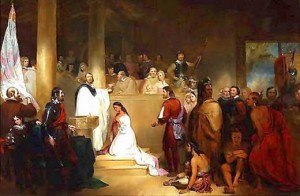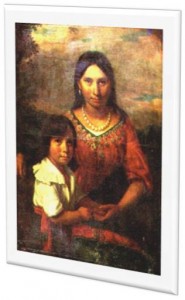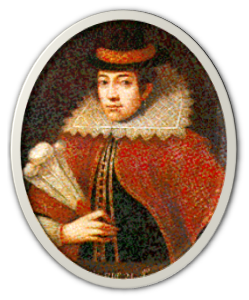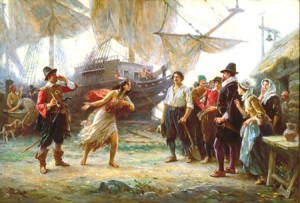To some, she is the stuff of legend. Perhaps that’s why Disney felt comfortable making a film that is largely fantasy. 
First, she was not an alluring young woman when she met Capt. John Smith; she was about ten years old. Fantasy is at work also in the image of John Smith here.
Pocahontas was fascinated with these English settlers. She spent time at the fort playing with the young boys. Her father, Chief Powhatan, didn’t mind her visiting his enemies because she could then provide intelligence about them.
When Smith went back to England, she was informed that he had died. Her link to the settlers was broken, and she stayed away for a few years.
A later Jamestown governor got the bright idea that the best way to get concessions from Chief Powhatan was to take something that he valued and then offer to trade. So he took Pocahontas. She was kidnapped by the settlers in order to force Powhatan’s hand.
Those plans were foiled when Powhatan refused to deal. A combination of Pocahontas’s interest in English culture and anger toward her father for his attitude led her to remain at Jamestown, where she was taught the Christian faith. She decided she wanted to be a Christian and was baptized.
 This painting of the baptism of Pocahontas can be seen in the Capitol rotunda in Washington, DC. Yes, it also has a little fantasy in its depiction of the baptism. There were no Roman columns in the New World. Yet the fact is that Pocahontas did become a Christian. She even took what she considered to be a Christian name: Rebecca.
This painting of the baptism of Pocahontas can be seen in the Capitol rotunda in Washington, DC. Yes, it also has a little fantasy in its depiction of the baptism. There were no Roman columns in the New World. Yet the fact is that Pocahontas did become a Christian. She even took what she considered to be a Christian name: Rebecca.
She also married one of the colonists: John Rolfe, a new settler who had recently lost his first wife. Their marriage was the beginning of a better time in the colony. It formed a bridge between the English and native cultures. Peace, however uneasy, resulted.
 Pocahontas gave birth to a son, Thomas. The Virginia Company, which had sponsored the Jamestown settlement, knew a good public relations coup when they saw it. The Rolfe family went to England, where the company could show off the Indian princess who had become a Christian. They hoped this would bring in more investors.
Pocahontas gave birth to a son, Thomas. The Virginia Company, which had sponsored the Jamestown settlement, knew a good public relations coup when they saw it. The Rolfe family went to England, where the company could show off the Indian princess who had become a Christian. They hoped this would bring in more investors.
Pocahontas liked England, and indications are that she wished to stay. Her Christian faith drew her closer to English culture. She even had her portrait painted while she was in England.
 This portrait is probably the most famous of all depictions of Pocahontas, who was now also known as Lady Rebecca.
This portrait is probably the most famous of all depictions of Pocahontas, who was now also known as Lady Rebecca.
As they were awaiting departure for the return trip to Virginia, Pocahontas became ill. They had to take her off the ship. As she lay dying, she told her husband not to grieve; it was the lot of everyone to die. She exhibited a calm assurance of eternal life.
Pocahontas–inquisitive child, peacemaker between cultures, voluntary convert to the Christian faith. In her twenty short years, she made an impact on American history, and her real story is much more significant than the stuff of legend.

